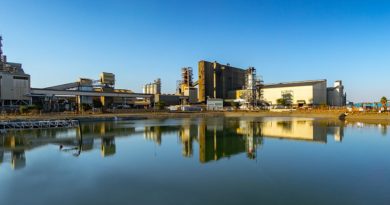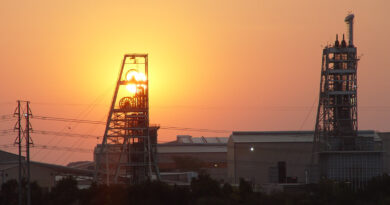Sibanye Stillwater: Normalised SA gold operations improve results
The build-up of gold production from the SA gold managed operations during H2 2022 following the industrial action and lockout during H1 2022 impacted Q3 2022 production and unit costs.
Normalisation of production from Q4 2022 and exposure to a higher gold price drove a significant turnaround from the managed SA gold operations during H1 2023, underlining what an important contribution SA gold operations can make to the bottom line during periods of production stability. During Q3 2023 however, the managed SA gold operations suffered two significant incidents which impacted production.
On 12 July 2023, a fire at Driefontein 5 shaft disrupted operations at both Driefontein 1 and 5 shafts. While most of the crews at Driefontein 1 were operational by the beginning of August 2023, the Driefontein 5 shaft crews were only gradually introduced back into the working places when it was safe to enter from 27 September 2023 after the fire had been extinguished and the ventilation had cleared all noxious gasses
In a second incident, on 30 July 2023, the Kloof 4 shaft, which had been operationally constrained by seismicity and cooling (associated with the chilled water reticulation circuit), was further impacted by an incident in the shaft caused when the ascending counterweight of the shaft conveyance encountered an unknown obstruction in the shaft, resulting in a number of ballast plates falling down the shaft, damaging the shaft infrastructure and preventing production from the 4 shaft area.
Production from the SA gold operations (including DRDGOLD) for Q3 2023 of 6,148kg (197,663oz) was 3% lower compared to Q3 2022, with gold production (excluding DRDGOLD) decreasing by 1% to 4,864kg (156,381oz). The decline in production was primarily due to the impact of the incidents mentioned above as well as the closure of Beatrix 4 shaft at the end of 2022.
AISC (including DRDGOLD) of R1,232,600/kg (US$2,062/oz) was 2% higher than for Q3 2022 with AISC (excluding DRDGOLD) 3% lower at R1,301,975/kg (US$2,178/oz). The decrease in AISC (excluding DRDGOLD) was a function of a 6% increase in gold sold year-on-year, which offset inflationary cost pressures on consumables and contractor rates and annual electricity tariff increases which rose 19% higher year-on-year.
In addition, ORD capital increased by 43% to R677 million (US$36 million) due to higher development rates compared with Q3 2022 when the operations were resuming after the strike and lockout.
Capital expenditure for Q3 2023 (excluding DRDGOLD) increased by 9% to R1.3 billion (US$71 million) compared to the same period in 2022 (affected by strike and lockout), with ORD increasing by 43% and corporate and project spend decreasing by 13% to R379 million
(US$20 million). Project capital mainly comprised R330 million (US$18 million) at the Burnstone project.
Sustaining capital declined by 14% to R255 million (US$14 million) mainly due to investment in lamp room upgrades at all the operations during Q3 2022 and electrical and winder upgrades which commenced during the industrial action in 2022 when the facilities and equipment were not in use.
Underground production for Q3 2023 from the Driefontein operation decreased by 11% to 1,452kg (46,683oz) compared to the same period in 2022, primarily due to the fire at 5 shaft which also impacted 1 shaft production, and reduced mineable face length at 4 Shaft following seismicity and resultant safety stoppages which are expected to persist to the end of the year. This impacted production by 132kg (4,244oz) for Q3 2023.
The impact of the lost production at 5 shaft due to the fire and the impact on 1 shaft was 798kg (25,656oz) during the quarter. Production from 5 Shaft recommenced in late September 2023 on a phased basis and is forecast to build up to full production by December 2023. AISC of R1,455,137/kg (US$2,435/oz) for Q3 2023 was 20% higher as a result of 2% lower gold sold, inflationary impacts as highlighted earlier which resulted in total operating costs increasing by 12%.
ORD costs increased by 63% due to higher development to increase mining flexibility and sustaining capital increased by 20% due to a change of scope in the 4 shaft pillar project (additional support work on 32/33 level tunnel and shaft infrastructure and new underground workshops), winder rope purchases and a water management project.
Underground production from the Kloof operation increased by 35% in Q3 2023 to 1,882kg (60,508oz) despite the major disruption at the Kloof 4 shaft due to the shaft incident, which impacted production by 790kg (25,399oz).
Increased production from the main and 8 shafts offset lower production from 4 shaft. The underground yield increased by 25% to 5.16 g/t, with the yield for Q3 2022 diluted by the build up in production from mining areas which stood dormant for three months.
Production from surface sources of 234kg (7,523oz), was 23% higher year-on-year as a result of higher grade surface areas being processed. AISC of R1,193,820/kg (US$1,997/oz) was 22% lower due to a 44% increase in gold sold year-on-year.
Operating costs were effectively managed following the Kloof 4 shaft incident by requesting employees affected by the shaft incident to take annual leave, limiting stores expenditure to shaft repair work and issuing a force majeure notice to non-critical contractors.
ORD increased by 41% to R246 million (US$13 million) on the back of a 55% increase in off-reef development while sustaining capital decreased by 28% to R108 million (US$6 million) due to lower spend following the Kloof 4 shaft suspension, which also resulted in reduced project capital investment.
Underground production of 933kg (29,997oz) in Q3 2023 from the Beatrix operation was 29% lower than for Q3 2022 primarily due to the closure of the Beatrix 4 shaft in Q1 2023, which resulted in approximately 193kg (6,205oz) less production relative to Q3 2022. AISC of R1,343,011/kg (US$2,247/oz) was 6% lower than for Q3 2022, due to total operating costs declining by 32% to R1.1billion (US$59 million) primarily as a result of the closure of the high cost Beatrix 4 shaft.
Tonnes milled by DRDGOLD for Q3 2023 decreased 21% year-on-year, however due to a 12% increase in grade, gold production of 1,284kg (41,282oz) was 12% lower than in Q3 2022. The decrease in the tonnes milled is as a result of load curtailment, the reclamation of
final remnant and clean-up material at operating sites nearing depletion at Ergo, Driefontein 5 shaft and the Far West Gold Recoveries on the West Rand. The increase in yield is associated with higher grade remnant material that is typically encountered during the final stages of reclamation and clean up, and the reclamation of high grade sand material at Ergo. Lower tonnes milled coupled with inflationary increases in key consumables and higher electricity costs, plus increased security costs and additional machine hire costs to enable the reclamation of final remnant material resulted in operating costs per tonne increasing by 45% to R198/tonne (US$11/tonne). This resulted in higher AISC of R963,694/kg (US$1,612/oz) which increased by 26% year-on-year due to the above increase in working costs and industry wide inflationary effects. DRDGOLD project capital also increased from R53 million (US$3 million) in Q3 2022 to R152 million (US$8 million) in Q3 2023 with spending on the solar power plant.




